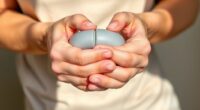To manage sleep apnea effectively, you should recognize signs like loud snoring, gasping, and daytime fatigue. Establish consistent sleep routines, optimize your sleeping environment by reducing noise and light, and support weight management through a healthy diet and regular exercise. Properly using and maintaining your CPAP device is essential, and managing other health conditions can improve outcomes. Building a strong support network and working closely with healthcare providers will help you succeed—keep going to discover more helpful tips.
Key Takeaways
- Recognize signs like loud snoring, morning headaches, and gasping to identify sleep apnea early in seniors.
- Establish consistent sleep routines, optimize bedroom environment, and limit disruptive light and noise for better sleep quality.
- Support weight management through healthy diet and regular moderate exercise to reduce sleep apnea symptoms.
- Ensure proper use, cleaning, and maintenance of CPAP devices for effective treatment and comfort.
- Foster open communication with healthcare providers and involve family or caregivers to monitor and manage symptoms effectively.
Recognizing the Signs and Symptoms of Sleep Apnea in Seniors

Sleep apnea often goes unnoticed in seniors because its signs can be subtle or mistaken for normal aging. You might notice your loved one snoring loudly, but they may not realize it’s more than just loud sleep sounds. Morning headaches, dry mouth, or sore throat can also be signs. Watch for abrupt awakenings or gasping during sleep, which indicate breathing interruptions. Daytime fatigue, irritability, or difficulty concentrating are common symptoms that many dismiss as aging or stress. Sometimes, sleep apnea manifests as restless sleep or frequent bathroom trips. Recognizing these signs early is essential, as untreated sleep apnea can lead to serious health issues like hypertension or heart problems. Being observant helps you catch the symptoms before they worsen. Additionally, hydrotherapy techniques such as aquatic exercises can support overall health and relaxation, potentially alleviating some symptoms associated with sleep disturbances.
Encouraging Healthy Sleep Habits and Routines
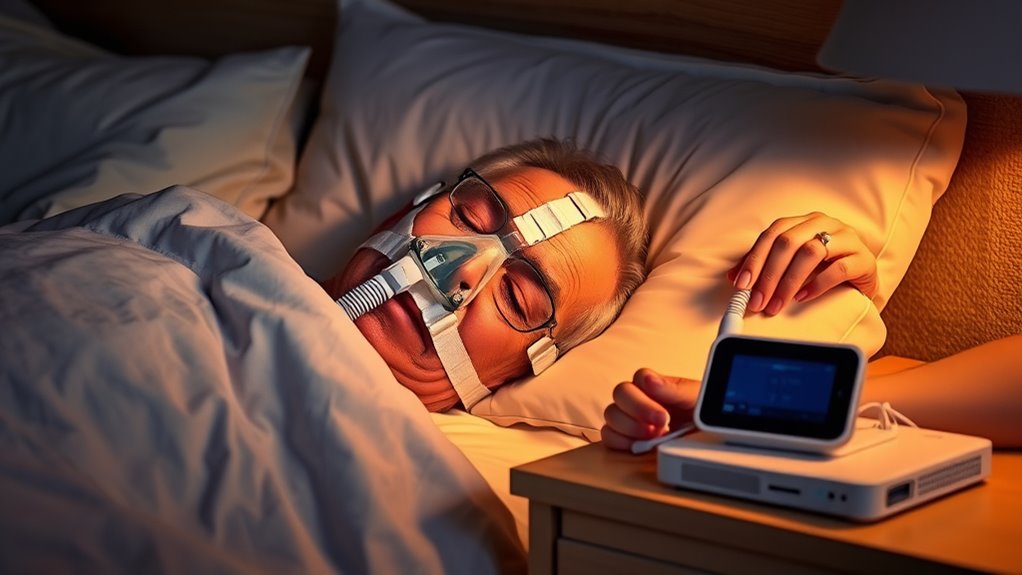
Establishing consistent sleep habits can substantially improve sleep quality for seniors. Creating a regular routine helps signal to the body that it’s time to wind down, making it easier to fall asleep and stay asleep. To support this, consider:
- Going to bed and waking up at the same times every day, even on weekends
- Avoiding caffeine and heavy meals close to bedtime
- Incorporating relaxing activities, like reading or gentle stretching, before bed
- Being aware of common sleep disorders like sleep apnea which can impact sleep quality and require medical attention
- Choosing a projector setup that minimizes light and noise disruptions can also contribute to better sleep environments for seniors.
- Monitoring signs of spoilage in sleep aids or medications to ensure they remain effective and safe to use.
- Additionally, using an air purifier with HEPA filters can help improve indoor air quality, reducing irritants that might interfere with restful sleep. Regular sleep assessments can help detect underlying issues early and tailor interventions effectively.
- Consistency reinforces your body’s internal clock, promoting better rest. Limiting daytime naps can also help prevent disruptions at night. Remember, small changes can make a big difference in sleep quality, especially when combined with other healthy habits. Prioritize your routine to help manage sleep apnea symptoms and improve overall sleep health.
Optimizing Sleep Environment for Better Rest
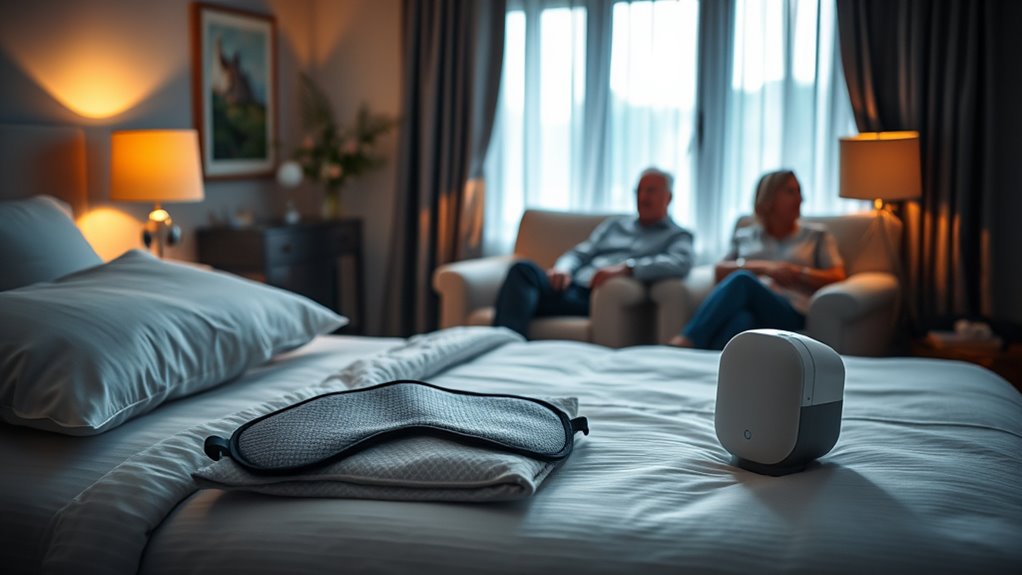
Creating a comfortable and quiet sleep environment is essential for seniors aiming to improve their rest. Start by ensuring your bedroom is cool, dark, and free of noise. Use blackout curtains or an eye mask to block out light, and consider earplugs or white noise machines to minimize disruptions. Keep your bed comfortable with supportive pillows and a suitable mattress. Remove clutter and distractions that can interfere with relaxation. Limit electronic devices before bedtime, as screens emit blue light that can hinder melatonin production. Maintain a consistent sleep schedule, even on weekends, to regulate your internal clock. A well-optimized sleep environment helps reduce sleep interruptions and promotes more restorative rest, especially important for managing sleep apnea symptoms. Incorporating necessary cookies can also help personalize your sleep environment settings and improve overall comfort. Additionally, choosing glycolic acid products with appropriate concentrations can support healthier skin and comfort around the face, contributing to better sleep quality. Ensuring a comfortable bedroom temperature is also crucial, as extreme temperatures can disrupt sleep cycles and exacerbate sleep apnea symptoms. Proper air circulation in the room can further enhance comfort and breathing quality during sleep.
Supporting Weight Management and Dietary Choices

Eating balanced meals and avoiding heavy foods can help manage your weight and improve sleep quality. When planning meals, focus on nutrient-rich options that keep you full without overloading your digestive system. Making mindful dietary choices supports better sleep and overall health for seniors with sleep apnea. Incorporating healthy eating habits can further enhance your sleep quality and overall well-being. Additionally, selecting foods with appropriate nutrient profiles can support your weight management goals and promote better rest. Being aware of nutritional information can help you make informed choices that align with your health objectives, especially when considering the importance of balanced meal composition in managing sleep-related issues. Understanding fetal development stages can also guide your dietary choices to support overall health during different phases of life.
Balanced Meal Planning
A balanced meal plan is essential for seniors managing sleep apnea, as it helps support healthy weight and overall well-being. Focusing on nutritious, portion-controlled meals can make a big difference. Incorporate a variety of foods to ensure you’re getting essential nutrients without excess calories.
Consider including:
- Plenty of vegetables and fruits for fiber and antioxidants
- Lean proteins like poultry, fish, or beans to promote fullness
- Whole grains such as oats or brown rice for sustained energy
Avoid processed foods high in sugar and unhealthy fats, which can contribute to weight gain and inflammation. Planning your meals with these principles helps maintain a healthy weight, reduces sleep apnea symptoms, and boosts your overall health.
Avoid Heavy Foods
Why should you avoid heavy foods when managing sleep apnea? Heavy, greasy, or large meals can cause indigestion and bloating, making it harder to breathe comfortably during sleep. These foods slow down digestion, increasing discomfort and raising the risk of acid reflux, which can worsen sleep issues. A full stomach can also lead to disrupted sleep cycles and frequent awakenings. By avoiding heavy foods, especially close to bedtime, you reduce these risks and promote better breathing. Instead, opt for lighter, nutrient-dense meals that support weight management and overall health. Keeping your dinner smaller and balanced helps prevent sleep disturbances linked to digestion problems, ensuring you get restful sleep and better manage your sleep apnea symptoms.
Promoting Regular Exercise and Physical Activity
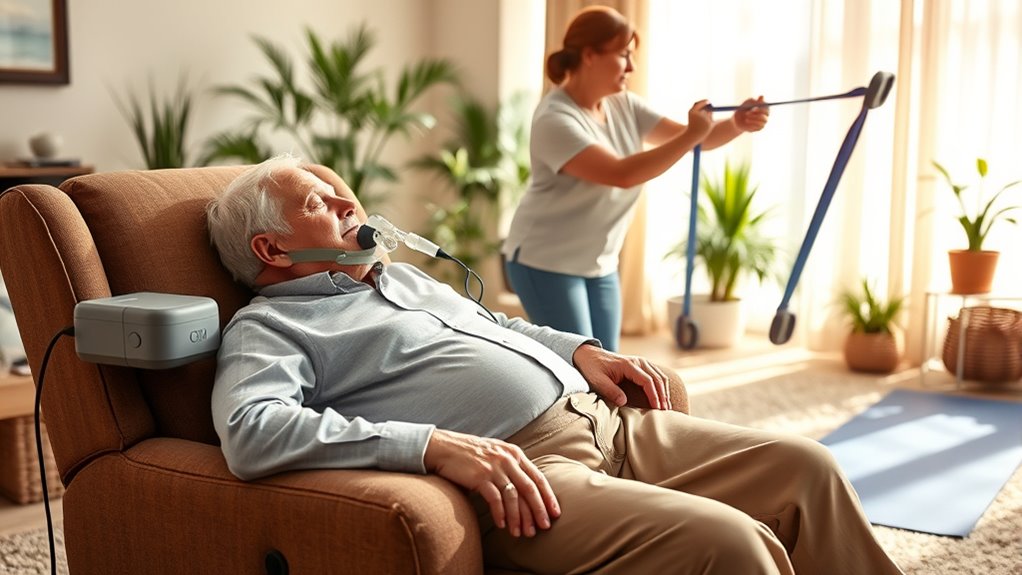
Encouraging regular exercise can improve your respiratory function, making breathing easier during sleep. It also helps manage weight, which is essential for reducing sleep apnea symptoms. By staying active, you support overall health and enhance sleep quality for seniors. Incorporating physical activity into daily routines can further strengthen respiratory muscles and promote better sleep patterns. Additionally, understanding tech integration can help protect personal health information from cyber threats.
Enhances Respiratory Function
Regular exercise and physical activity can substantially improve respiratory function, which is especially important for seniors managing sleep apnea. When you stay active, your lungs become stronger, and your breathing becomes more efficient. This helps reduce the severity of sleep apnea symptoms and promotes better rest. Consistent movement also increases your overall lung capacity, making it easier to breathe deeply and fully. Plus, staying active can improve your endurance and reduce fatigue during the day. To boost respiratory health, consider activities like:
- Walking briskly for 30 minutes daily
- Gentle swimming or water aerobics
- Breathing exercises such as diaphragmatic breathing
Incorporating these habits into your routine supports better airflow and helps manage sleep apnea more effectively.
Supports Weight Management
Engaging in consistent physical activity helps seniors manage their weight effectively, which is essential for controlling sleep apnea symptoms. Regular exercise burns calories and builds muscle, helping maintain a healthy weight. When you stay active, you’re less likely to carry excess weight around your neck and chest, which can contribute to airway obstruction during sleep. Incorporate activities like walking, swimming, or gentle aerobics into your routine—aim for at least 150 minutes per week. Physical activity also boosts your metabolism and improves overall health, making it easier to stick to healthy eating habits. Remember to choose exercises you enjoy and consult your healthcare provider before starting a new routine. Staying active is a key step toward better sleep quality and managing sleep apnea effectively.
Ensuring Proper Use and Maintenance of CPAP Devices

Proper use and maintenance of CPAP devices are essential to guarantee effective sleep apnea treatment and avoid complications. Regularly cleaning your mask, tubing, and water chamber prevents bacteria buildup and ensures comfort. Check that your device is functioning correctly each morning, and replace filters as recommended. Keep your device in a safe, dry place, avoiding dust and direct sunlight. To make maintenance easier, consider these tips:
Regular cleaning and proper maintenance ensure effective sleep apnea treatment and device longevity.
- Clean your mask and tubing weekly with mild soap and water
- Replace filters every 1-2 months or as specified
- Schedule regular check-ups with your healthcare provider to ensure proper device function
Staying consistent with these practices helps you breathe easier, sleep better, and extend your device’s lifespan.
Managing Coexisting Health Conditions Effectively

Managing coexisting health conditions alongside sleep apnea is essential because these conditions can influence your overall health and the effectiveness of your treatment. When you control other health issues, like hypertension or diabetes, you reduce the strain on your body and improve sleep quality. Keep track of your symptoms and follow your healthcare provider’s advice for managing each condition. Taking medications as prescribed, maintaining a healthy diet, and staying active help stabilize your health. Regular check-ups allow your doctor to monitor your progress and make adjustments if needed. Avoid ignoring new or worsening symptoms, and communicate openly about how your sleep apnea treatment impacts other health issues. By managing these conditions effectively, you enhance your overall well-being and improve your sleep quality. Additionally, understanding the importance of comprehensive retirement planning can help ensure your long-term financial security while managing health concerns. Being aware of comorbidities and how they interact with sleep apnea can lead to more personalized and effective treatment strategies. Recognizing the role of disease management in your overall health can further support better outcomes. Maintaining a healthy lifestyle through balanced nutrition and regular exercise can also significantly improve your condition and quality of life.
Building a Support System and Communicating With Healthcare Providers
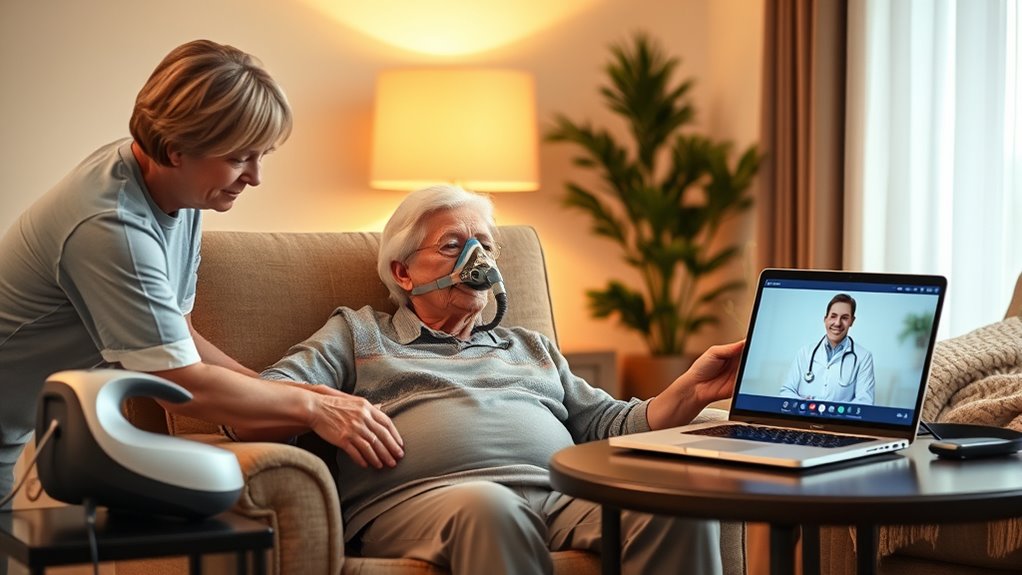
Building a strong support system and maintaining open communication with healthcare providers can substantially improve your sleep apnea management. When you involve family, friends, and caregivers, you create a network that encourages adherence to treatment plans and provides emotional support. Regularly update your healthcare team on your symptoms, sleep quality, and any concerns. This helps them tailor treatments to your needs and catch issues early. Consider these tips:
- Share your experiences honestly to get the right advice
- Keep a sleep journal to track patterns and symptoms
- Don’t hesitate to ask questions or voice concerns during appointments
Building this open dialogue ensures you get the best care possible, making managing sleep apnea more effective and less stressful.
Frequently Asked Questions
How Can Caregivers Detect Sleep Apnea in Seniors Who Are Non-Verbal?
You can identify sleep apnea in non-verbal seniors by observing signs like loud snoring, choking, or gasping during sleep. Watch for daytime fatigue, irritability, or frequent awakenings. Use a sleep diary to track patterns and discuss concerns with healthcare providers. If possible, consider a sleep study, which offers definitive diagnosis. Your attentiveness and prompt action can help guarantee they receive proper treatment and improve their quality of sleep.
Are There Alternative Treatments to CPAP for Seniors With Sleep Apnea?
Considering complex curation, you’ll find several solutions beyond continuous positive airway pressure (CPAP). Alternatives like mandibular advancement devices gently shift your lower jaw forward, reducing airway obstruction. Positional therapy encourages sleeping on your side to prevent apnea episodes. In some cases, surgery may be suitable for removing obstructions or enlarging airways. Always consult a healthcare professional to tailor treatments, ensuring safer, sounder sleep and better breathing during rest.
How Does Sleep Apnea Affect Cognitive Health in Older Adults?
Sleep apnea can considerably impact your cognitive health by disrupting your sleep cycles, leading to issues like memory problems, difficulty concentrating, and slower thinking. When your oxygen levels drop during episodes, it strains your brain, increasing the risk of conditions like dementia over time. Managing sleep apnea effectively helps protect your cognitive function, ensuring you stay sharper, more alert, and healthier overall.
What Role Does Medication Management Play in Sleep Apnea Care?
Think of medication management as guiding a ship through foggy waters. You play a vital role in ensuring the right medications are used to control sleep apnea symptoms, reducing risks like breathing interruptions. You need to monitor side effects, coordinate with healthcare providers, and adjust treatments as needed. By doing so, you help clear the fog, allowing your loved ones to breathe easier and enjoy more restful sleep.
How Can Families Effectively Coordinate Sleep Apnea Treatment Plans?
You can effectively coordinate sleep apnea treatment plans by staying informed and involved. Communicate openly with healthcare providers to understand the prescribed therapies and guarantee everyone’s on the same page. Keep track of appointments, medications, and device usage. Support your loved one by encouraging adherence to treatment, monitoring symptoms, and addressing concerns promptly. This proactive approach helps improve treatment outcomes and ensures your family member receives thorough, consistent care.
Conclusion
Just like the steady rhythm of a song, managing sleep apnea requires ongoing effort and support. By recognizing signs, creating a healthy routine, and working with healthcare providers, you can help your loved one breathe easier and enjoy better rest. Remember, you’re guiding them through a journey much like a lighthouse guiding ships safely home—steadfast and caring. With patience and dedication, peaceful nights and brighter days are within reach.

